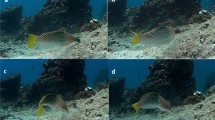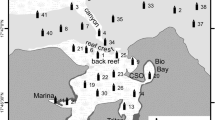Abstract
Being able to tie their body into a knot is beneficial to some moray eels and other cylindrical vertebrates for various reasons, although not all morays’ tie knots. Knot tying can generate leverage for feeding activity by moving the knot up the body, and this leverage may be affected by knot type. Three types of knots are known to have been used by morays’ and this study further elucidates this behaviour and ability. Baited Remote Underwater Videos (BRUVs) were used to compare knot tying between the moray eels Gymnothorax prasinus and Gymnothorax prionodon in the Solitary Islands region, eastern Australia. Gymnothorax prasinus tied more knots overall and more types of knot than G. prionodon (five types vs one type, respectively). Both tied the overhand knot and this was the most common knot used by G. prasinus. The figure of eight knot was used two times more than the double overhand knot, being relatively wider and likely easier to move up the body. Gymnothorax prasinus also tied two undescribed knots, now called the ‘moray knot’ and the ‘morays banana knot’, which have more crossings and are bulkier, increasing potential for generating leverage. However, their uncommon use indicates costs may outweigh benefits of these more complex knots. Lower habitat complexity in deeper waters may influence differences in knot tying as G. prasinus were only recorded shallower than 40 m and G. prionodon mainly deeper. These findings further reveal the utility and complexity of knot tying in moray species and cylindrical vertebrates generally.




Similar content being viewed by others
References
Ashley CW (1998) The Ashley Book of Knots. First printed 1944, reprinted DoubleDay, New York
Barley SC, Mehta RS, Meeuwig JJ, Meekan MG (2015) To knot of not? Novel feeding behaviours in moray eels. Mar Biodiv. doi:10.1007/s12526-015-0404-y
Beukers JS, Jones GP (1997) Habitat complexity modifies the impact of piscivores on a coral reef population. Oecologia 114:50–59
Bohlke EB, McCosker JE (2001) The moray eels of Australia and New Zealand, with the description of two new species (Anguilliformes: Muraenidae). Rec Aus Museum 53:71–102
Cappo M, Harvey E, Malcolm H, Speare P (2003) Potential of video techniques to monitor diversity, abundance and size of fish in studies of Marine Protected Areas. In: Beumer JP, Grant A, Smith DC (eds) Aquatic Protected Areas - what works best and how do we know?, Cairns, Australia, 2002 Proceedings of the World Congress on Aquatic Protected Areas. 455–464
Chave EH, Randall HA (1971) Feeding behaviour of the moray eel, Gymnothorax pictus. Copeia 1970(3):570–574
De Sylva PD (1986) The gulper eel and its knotty problem. Sea Frontiers 32(2):104–108
Fishbase (2016): http://www.fishbase.org/summary/Gymnothorax-prasinus.html
Graham NAJ, Purkis SJ, Harris A (2009) Diurnal, land-based predation on shore crabs by moray eels in the Chagos archipelago. Coral Reefs 28:397
Graumont R, Wenstrom E (1988) Fishermans knots and nets. Cornell Maritime Press, Maryland
Hanlon RT, Conroy LA, Forsythe JW (2007) Mimicry and foraging behaviour of two tropical sand-flat octopus species off North Sulawesi, Indonesia. Biol J Linn Soc 93:23–38
Harasti D, Malcolm HA, Gallen C, Coleman MA, Jordan A, Knott NA (2015) Appropriate set times to represent patterns of rocky reef fishes using baited video. J Exp Mar Biol Ecol 463:173–180
Helfman GS, Clark JB (1986) Rotaional feeding: overcoming gape-limited foraging in anguillid eels. Copeia 1986(3):679–685
Jensen D (1966) The hagfish. Sci Am 214(2):82–90
Jordan A, Davies P, Ingleton T, Mesley E, Neilson J, Pritchard TR (2010) Seabed habitat mapping of continental shelf waters of NSW. NSW Department of Environment Climate Change and Water Occasional Paper Series 209
Kuiter RH (2000) Coastal fishes of South-Eastern Australia. Gary Allen Pty Ltd, Sydney
Luiz OJ, Mendes TC, Barneche DR, Ferreira CGW, Noguchi R, Villaca RC, Rangel CA, Gasparini JL, Ferreira CEL (2015) Community structure of reef fishes on a remote oceanic island (St Peter and St Paul’s archipelago, equatorial Atlantic): the relative influence of abiotic and biotic variables. Mar Freshw Res 66:739–749
Malcolm HA, Gladstone W, Lindfield S, Wraith J, Lynch TP (2007) Spatial and temporal variation in reef fish assemblages of marine parks in new South Wales, Australia - baited video observations. Mar Ecol Prog Ser 350:277–290
Malcolm HA, Jordan A, Smith SDA (2011) Testing a depth-based habitat classification system against the pattern of reef fish assemblages (15 - 75 m) in a subtropical marine park. Aq Conserv 21:173–185
Mehta RS, Wainwright PC (2007) Raptorial jaws in the throat help moray eels swallow large prey. Nature 449:79–82
Mehta RS, Wainwright PC (2008) Functional morphology of the pharyngeal jaw apparatus in moray eels. J Morphol 269:604–619
Mehta RS, Ward AB, Alfaro ME, Wainwright PC (2010) Elongation of the body in eels. Integr Comp Biol 50:1091–1105
Miller TJ (1987) Knotting: a previously undescribed feeding behaviour in Muraenid eels. Copeia 1987(4):1055–1057
Miller TJ (1989) Feeding behaviour of Echidna nebulosa, Enchelycore pardalis, and Gymnomuraena zebra (Teleostei: Muraenidae). Copeia 1989(3):662–672
Owen P (1996) Knots. Simon and Schuster, Australia
Petit P (2013) Why knot? Abrams Image, New York
Pickwell GV (1971) Knotting and coiling behaviour in the pelagic sea snake Pelamis platurus. Copeia 1971(2):348–350
Prugh LR, Stoner CJ, Epps CW, Bean WT, Ripple WJ, Laliberte AS, Brashares JS (2009) The rise of the mesopredator. Bioscience 59(9):779–791
Santos FB, Castro RMC (2003) Activity, habitat utilization, feeding behaviour, and diet of the sand moray Gymnothorax occelatus (Anguilliformes, Muraenidae) in the south western Atlantic. Biota Neotropica 3:1–7
Smith HG (1986) The marlinspike sailor. Jonh de Graff Inc., Clinton Corners
Smith DG (2012) A checklist of the moray eels of the world (Teleostei: Anguilliformes: Muraenidae). Zootaxa 3474:1–64
Zintzen V, Roberts CD, Anderson MJ, Stewart AL, Struthers CD, Harvey ES (2011) Hagfish predatory behaviour and slime defence mechanism. Sci Rep 1:131. doi:10.1038/srep00131
Acknowledgments
The field work was conducted as part of NSW Department of Primary Industries (NSW DPI) marine ecosystem research under NSW DPI Ethics approval ACEC Ref 10/09. The analyses of the knot tying and writing of this manuscript were carried out in the author’s own time due to the more esoteric nature of this study in relation to NSW DPI core research. Individuals who have assisted with field work include Arthur Schultz, Rob Thorman, Nicola Johnstone, Brett Vercoe, Andrew Benson and Mike Davey. Thanks also to Jim Seager at SeaGIS for various support over the years and to Toby Waters for knot tying discussions and a loan of ‘Why Knot?’ by Philippe Petit, an inspirational knot tyer. Thanks very much to Des Pawson, one of the founders of the International Guild of Knot Tyers and owner of the Museum of Knots and Sailors Ropework who confirmed that he also could not find a name for the two knots and suggested I coin a name for them involving morays. Improvements to the manuscript were made from suggestions by colleagues at DPI: Dave Harasti and Nathan Knott and by the manuscript Reviewers.
Author information
Authors and Affiliations
Corresponding author
Electronic supplementary material
ESM 1
(XLSX 35 kb)
Rights and permissions
About this article
Cite this article
Malcolm, H.A. A moray’s many knots: knot tying behaviour around bait in two species of Gymnothorax moray eel. Environ Biol Fish 99, 939–947 (2016). https://doi.org/10.1007/s10641-016-0535-4
Received:
Accepted:
Published:
Issue Date:
DOI: https://doi.org/10.1007/s10641-016-0535-4




